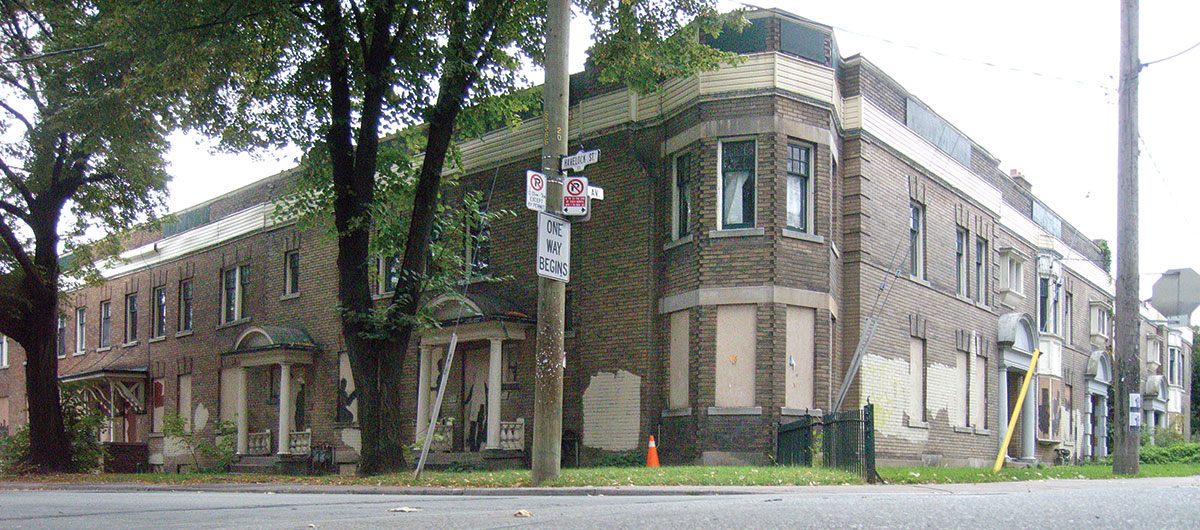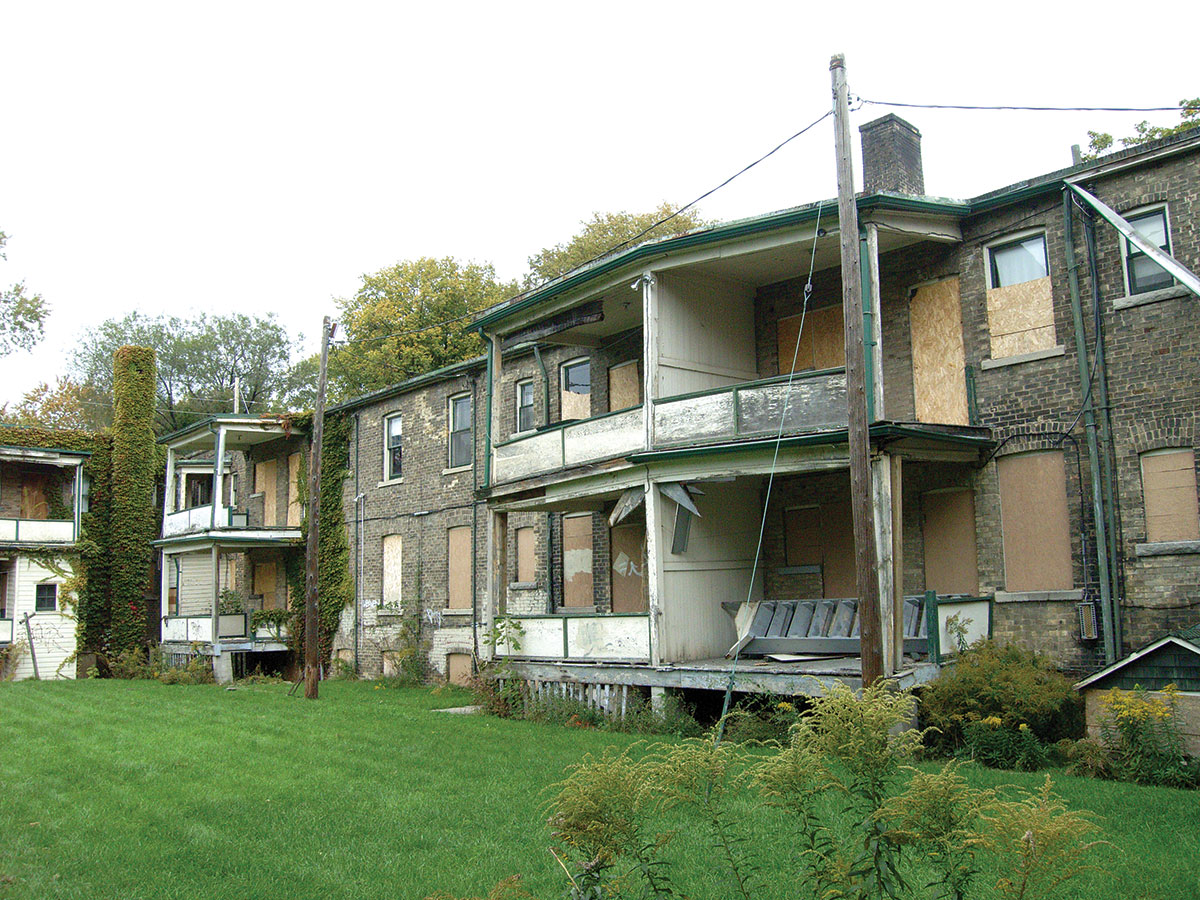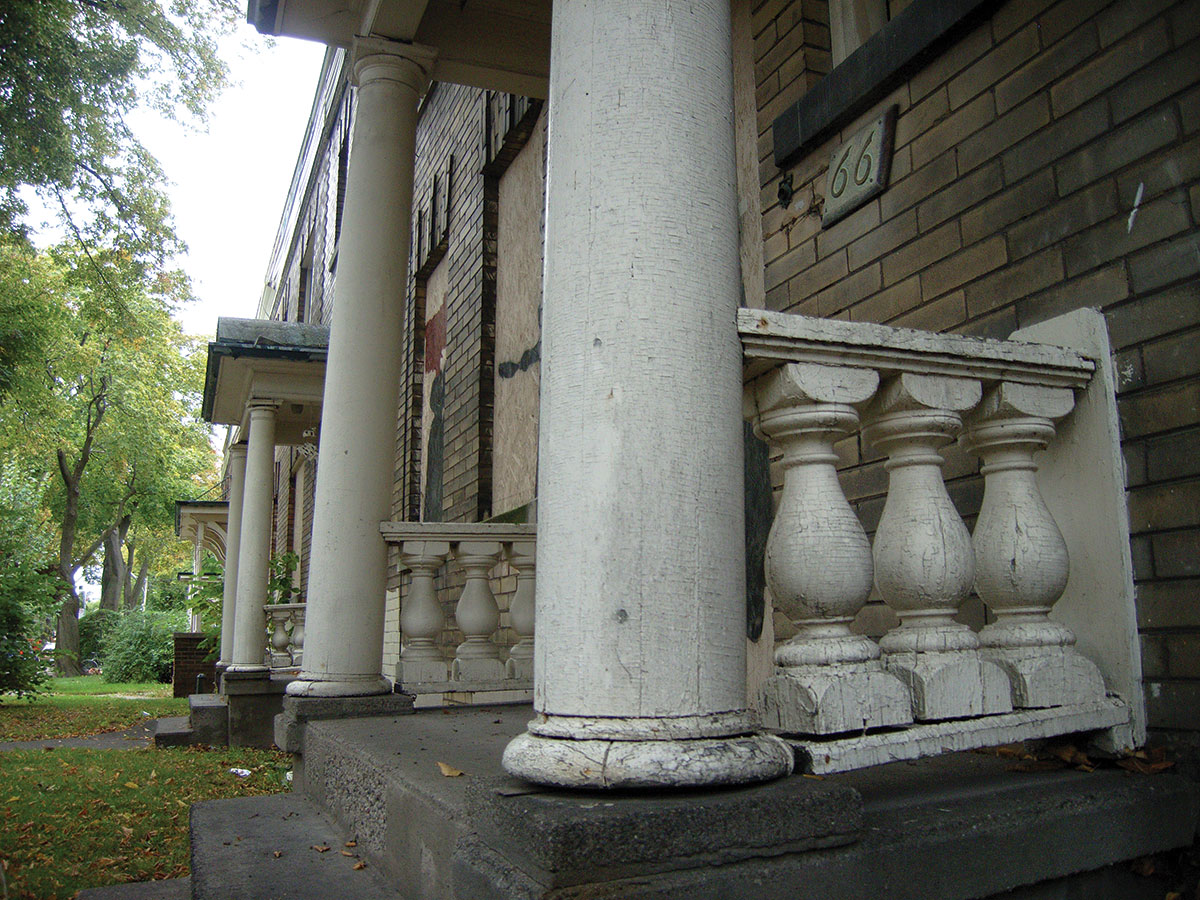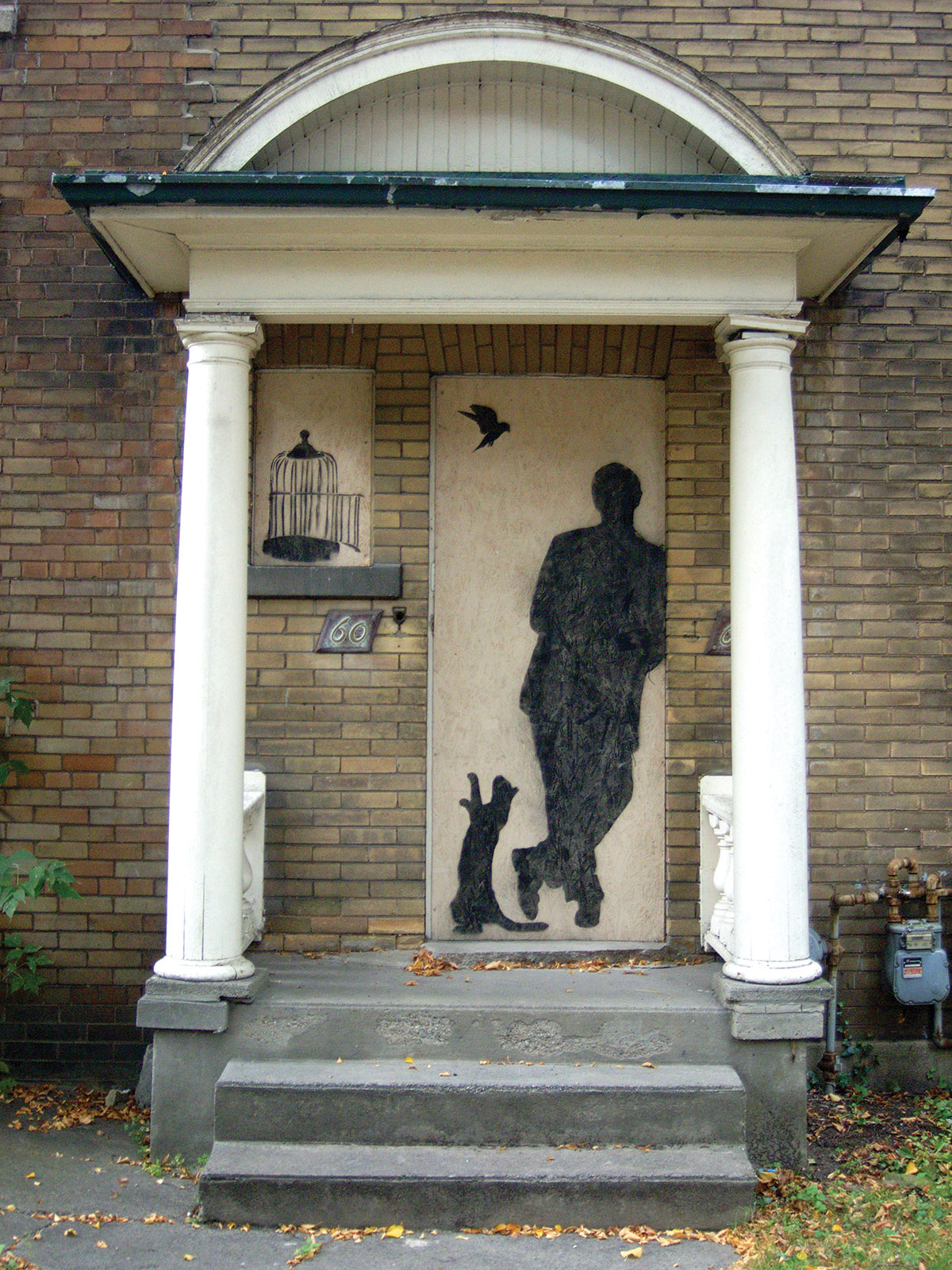
When Sheila Ziman first walked through the door of a ground-floor unit in the Sylvan Apartments, she thought, “I will never rent this place.” The space was as gloomy as a mushroom garden, and she couldn’t imagine her life fitting into the four small rooms already crammed with heavy furniture. “There was this flocked fleur-de-lys wallpaper, and everything was so dark and dull,” she recalls today. Ziman, an English-as-a-second-language teacher, turned and walked out, resigned to continue her search for affordable rental housing in downtown Toronto. But something about the apartment stuck in her mind. A week later she returned, strode into the room, and threw open the curtains. Light made the space magic. From the porch she saw roses and a magnolia tree growing in a back garden. In the bathroom was a huge pedestal sink. A beautiful hardwood floor ran through the whole the apartment. “I saw that the rooms were absolutely huge and the ceilings were high,” Ziman says. “And I thought, ‘Yeah, I can make this work.’”
Nearly three decades later, the magnolia tree Ziman admired is still there, but the life of the century-old Sylvan is at an end. Its dark wood exterior doors are boarded up, graffiti sprayed across the particleboard like a hieroglyph eviction notice. The bricks are chipped, and the two-storey back porches are sinking into the ground. Lacy curtains still blow uncannily in an upstairs window. Yet, for all its eerie decay, the Sylvan doesn’t look quite ready for the wrecking ball. Rolled-up newspapers lie in a doorway, waiting to be read. Stenciled graffiti of a kissing couple and a bird-chasing cat almost bring the shuttered building to life. And, in the summer, the back garden still overflows with hot pink and red roses.
I first discovered the Sylvan, located at 48 Havelock Street, at the corner of Sylvan Avenue, on a trip to the grocery store three years ago, shortly after moving to the Dufferin Grove neighbourhood. Having spent most of my life in the midtown Toronto of concrete apartment buildings—those elephant-grey tomes to Modernism that scrape the sky with their monotonous efficiency—I was captivated by the Sylvan’s Grey Gardens quality, its Edwardian classicism. I set down my grocery bags and wondered how this huge, weirdly appealing ghost house was allowed to decay in the middle of the city. Who had lived here? I was struck by how the Sylvan seemed designed to draw people out of their private spaces, with balconies and porches built around the inviting back garden, which resembled a quaint public square. I decided to find out as much as I could about the Sylvan before it seemingly, inevitably, lamentably became a hole in the ground.

The story of the Sylvan is as much tied to the picturesque Dufferin Grove as it is to the family who owned it for nearly a hundred years. A middle-class neighbourhood in the city’s downtown west end—bounded by College Street to the south and Bloor to the north, between Dufferin and Ossington—Dufferin Grove is a neighbourhood of semi-detached and single-family Victorian homes. While many still function as such, others have been subdivided into apartments populated by young professionals or students. Modest Japanese cars line driveways, and residents like to shop at the thriving farmers’ market. In an area like this, the Sylvan, a low-occupancy rental building, is something of a beautiful anomaly.
It must have been just as anomalous in 1910, the year it was built. In the early twentieth century, Dufferin Grove had the appearance of a gated village for the home-owning class. In vintage sepia-washed photos, women stroll with parasols through Dufferin Grove Park, and merchants sell bananas from carts. There is the impression of endless space, of genteel rural life come to the city. Dufferin Street, the Sylvan’s closest main thoroughfare, was a barren, real-estate developer’s dream.
Toronto first turned to multiple-resident housing in the period before the First World War. The Sylvan’s architect, James A. Harvey, was noted as one of the first in the city to focus on designing low-rise apartment houses. Originally running west along Sylvan Avenue from Havelock, with its balustrade pillars and solid brown-brick exterior, the Sylvan was the epitome of comfortable, affordable Edwardian Toronto living. In 1927, an additional row of apartments was attached to the Sylvan, down Havelock Street, surrounding the backyard and creating the unique L-shaped building that exists today.
The Sylvan was developed by Harry Hutson, of the real-estate firm J. T. & H. Hutson. Hutson’s building met the increasing demand for accessible housing with consideration and care. The two one-bedroom and fourteen two-bedroom units were approximately seven hundred and nine hundred square feet, respectively. Along with the pedestal sinks, each unit’s bathroom was outfitted with either a cast-iron deep soaker or a claw-foot tub, and residents had access to a large basement storage space. A row of garages stretched across the back of the property, and most units led out to private balconies and porches overlooking the garden. Beautiful and spacious, the Sylvan offered working-class renters all the trimmings enjoyed by middle-class homeowners—a 1924 classified in the Toronto Star lists the price of a five-room unit at fifty dollars. By the time Ziman left her sunny two-bedroom apartment, in 2003, her rent was approximately seven hundred dollars a month. “People didn’t leave the Sylvan unless they died or bought a house,” she says.
City directories of the day suggest many of the Sylvan’s early tenants were involved in service-based work: store clerks, assistant managers, and the like. Units were rented by a diverse population and included single women, the elderly, and bachelors. Clare McGarrigle, a teacher who rented a two-bedroom apartment on the second floor of the Sylvan throughout the nineties, recalls the day she was cleaning her fireplace and discovered a piece of paper behind the mantle. “It was this little card from someone called Leckie—his Air Force or flying club card. It was very special and I kept it,” she says.
Management of the Sylvan was likely overseen by Arthur Hutson, Harry’s brother, who lived one street east with his family in a foursquare home on the grand Rusholme Road. Upon Arthur’s death, responsibility for the building fell to his daughter, Gwendoline, who eventually moved into the Sylvan’s southernmost second-floor apartment.
“She preferred to be called Miss Hutson,” McGarrigle says. Despite a name worthy of a debutante in a Henry James novel, Miss Hutson was no Pollyanna. Ziman remembers her as a down-to-earth woman whose greatest vice was a taste for pearls, gloves, and hats—a throwback to her genteel Rusholme Road upbringing. Hutson, who worked as a secretary as a young woman, remained unmarried into her old age, still living in the same apartment—a place that Ziman recalls as being “old and cracked, cluttered with knick-knacks” by the nineteen-nineties. The Sylvan’s rose garden was Hutson’s pet project. In the summertime, when the backyard became a sunning spot for neighbourhood cats, she donned a long flowered housedress and a straw hat with a large brim and tended her flowers. The back garden was such a point of pride Hutson asked tenants not to hang laundry on Sundays. “She thought it looked bad for the building,” says McGarrigle.
Even in her later years, Hutson refused to leave the Sylvan. Eventually, she stopped renting the apartment below her own, in the event she needed to house a caregiver on-site. But she never required the use of her nurse’s quarters—Hutson died, in 2003, in hospital, at the age of ninety. Her funeral was held at the nearby St. Anne’s Church, on Gladstone Avenue. Many of Hutson’s mourners were tenants, who likely knew that her passing would end an era of community that had defined the Sylvan.
“I knew that the Sylvan would be torn down and someone would make a mint,” Ziman says. “It always made me sad that [Miss Hutson] could have made money selling it and gone to live in some nice place. But that’s not the kind of person she was.”

Months after her death, Gwendoline Hutson’s estate sold the Sylvan to J.D.C. Property Management. Although tenants realized some kind of change was possible, they were reassured by a city bylaw passed the previous year limiting developers from demolishing or replacing rental properties with condos. As the Toronto Star stated in an editorial on February 25, 2002, “It’s not enough for Toronto to build some new affordable housing; council has to protect what stock it has.”
But in October, 2004, despite not yet having applied to develop the property, J.D.C. served the Sylvan’s tenants with notices to evict. The building’s heat was reportedly lowered throughout the winter, and the property was allowed to deteriorate. Some tenants say they were told by the property management to expect things to get worse. Many moved, and their units were boarded up. Although the city intervened and the evictions were withdrawn, the next year J.D.C. applied for an application to demolish the Sylvan and replace it with a forty-five-unit condominium townhouse with an underground parking garage. Neighbours voiced the usual concerns of increased density and building height, and tenants were offered replacement units at a still-to-be-developed J.D.C. site on Dovercourt Road, though obviously it would be nothing as luxurious as they had known at the Sylvan. But stopping the demolition of an affordable rental property and replacing it with private housing was the primary concern for the city, which rejected the proposal outright and, in 2006, designated the Sylvan a property of cultural heritage value, citing its “architectural significance as a well-designed early 20th century apartment.”
For two years the Sylvan existed in purgatory, as J.D.C. appealed the city’s decision and tenants continued to move out. More than half of the Sylvan’s sixteen units were vacant by the time J.D.C.’s case reached the Ontario Municipal Board in 2007, by which time the city, in a closed-door meeting, had agreed to a revised proposal provided certain conditions were met, including the retention of the faÁade of the original 1910 portion of the building, and making ten rental units available at the Dovercourt site to existing tenants. In its decision, the O.M.B. agreed with the city, saying it did not feel that J.D.C.’s proposal was an overdevelopment, nor that the city’s willingness to lose sixteen affordable rental units was out of line with its housing policies. With the O.M.B.’s decision, the ninety-seven-year-old Sylvan was lost.
Lynda Macdonald, a manager in the city’s planning department who oversaw the Sylvan through the hearing process, says extenuating circumstances made it next to impossible to save the apartments. The building was in such a deteriorated state at the time of Miss Hutson’s death that it did not qualify for designation under the highest category of protected historical properties. Furthermore, the fact that many of the tenants had moved out by 2005 nullified the argument that redevelopment was displacing real people, not just vacant units. “We generally don’t like to preserve just a wall. The part of the faÁade that will be preserved will be the most recognizable and decorative part of the building,” Macdonald says. “Was the resolution ideal? No. But can we live with this? Yes.”
Dan McIntyre, the former program co-ordinator for outreach and organization with Federation of Metro Tenants’ Associations, says the case of the Sylvan Apartments is a prime example of how the city failed to maintain affordable housing for its population when the market failed to do so. “Of all the cases I’ve seen over the last ten years, this one saddens me the most,” he says. “[This is] planning gone wrong and affordable housing issues being subjugated to the wishes of the developer.”
J.D.C. can not redevelop the Sylvan site until displacement housing for the Sylvan’s tenants is completed. The developer says construction of the Dovercourt building has been stalled by the current economic climate, and city representatives says they do not know when development will begin. (A J.D.C. representative did not return calls to comment on this story.) Meanwhile, the Sylvan remains vacant.

Graffiti at the shuttered 60 Havelock Street.
In the end, the Sylvan is less a ghost story than a relic from an era when renting didn’t have to be a compromise. The building gave working people amenities usually associated with home ownership. It was a place where people lived well even if they weren’t well off—an idyll that likely will never again be possible for the average renter in downtown Toronto.
I returned to the Sylvan’s garden this summer. It was a steamy July afternoon, so bright that the roses shimmered like Kool-Aid. As I walked in the prickly grass, I felt wistful. It’s easy to imagine life here: Miss Hutson in her flowered housedress, a woman owner in a city of men, her sleeves rolled up for work. Housewives with clothespins in their mouths hanging laundry. A clothesline of history stretching one hundred years.
Having walked the perimeter of the garden, I stopped, like Romeo, below one of the weathered balconies. Although I wasn’t bearing a soliloquy, or even a Dollarama birthday card, I did bring what I believe old buildings, with their crumbliness, their unloved rooms, their low rates of return, need from us most—imagination. Only with imagination can places such as the Sylvan transform from cobwebbed capsules of history to viable opportunities. This is especially true in Toronto, where more than sixty thousand people sit on a waiting list for affordable housing while the Sylvan’s sixteen units remain empty. Only with imagination can we find creative ways of renewing buildings like the Sylvan, so they can continue to speak of history—and provide a future. “People didn’t leave the Sylvan unless they died or bought a house,” I recall Sheila Ziman telling me, and now I can see why. There is a sense of peace here. In fact, it feels like a home.

Miss Hutson’s roses continue to bloom in 2010.